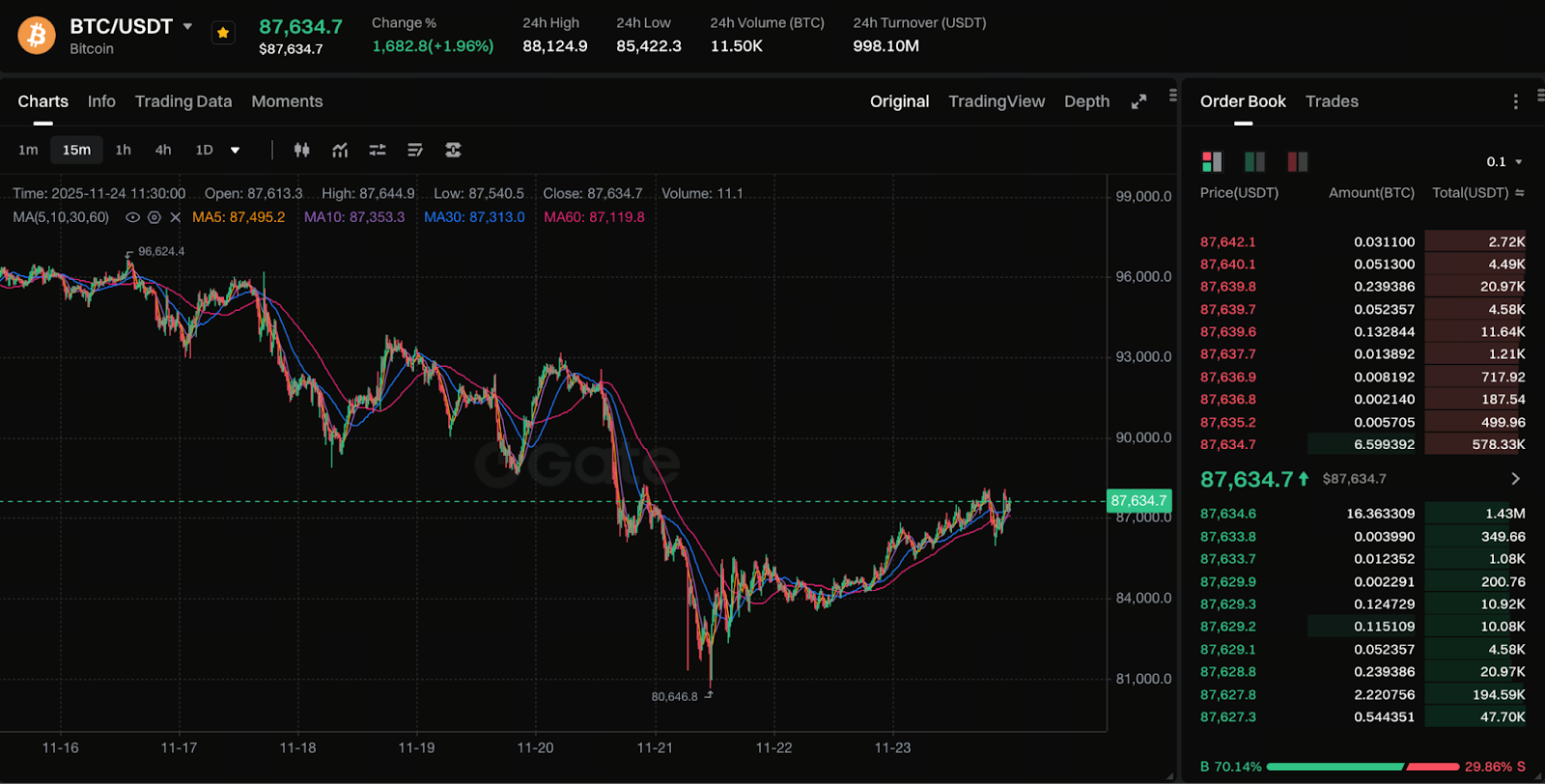Bitcoin Pullback Shock: Why Did MicroStrategy’s Stock Drop Below $185?
Correction Arrives: A Breakdown of Recent Bitcoin Price Movements

Chart: https://www.gate.com/trade/BTC_USDT
The crypto market has seen renewed volatility in recent days. Bitcoin has dropped over 30% from its yearly high, facing heavy selling pressure. According to Investing.com, a wave of leveraged liquidations forced institutions and exchanges to close positions, sending Bitcoin below the $90,000 mark. This development has directly shaken confidence in high-risk assets. As the leader of the digital asset ecosystem, Bitcoin’s correction has quickly affected the broader market.
Inside the MicroStrategy Model: Why Its Stock Moves With Bitcoin
MicroStrategy (NASDAQ: MSTR) began as a software and business intelligence company. After pivoting to become a publicly traded Bitcoin proxy, its stock performance has tightly tracked Bitcoin’s price. Currently holding over 649,000 Bitcoins, the company remains the largest corporate Bitcoin holder, according to Yahoo Finance. The company’s business model works as follows: it issues shares or convertible bonds. It uses the capital to buy Bitcoin. The company then benefits from Bitcoin’s price appreciation, which boosts its book value and, in turn, its stock price premium. Conversely, when Bitcoin falls, the stock price drops as well. The most recent data shows its stock price has slipped from a mid-year high of about $456 to around $186. As a result, Bitcoin’s correction has sharply increased MicroStrategy’s risk exposure.
Stock Price Breaks Critical Level: What Does $185 Signify?
Barchart reports that MicroStrategy’s stock price has dropped below its book value for the first time. Previously, the stock consistently traded at a premium to its Bitcoin holdings. When MSTR falls to around $185, it shows investors are no longer willing to pay extra for its Bitcoin exposure. Technically, losing this psychological support can trigger more stop-loss selling. At the same time, analysts warn the company may risk removal from major indexes. In this scenario, impacted by Bitcoin’s correction is an apt description: Bitcoin’s downturn directly causes MicroStrategy’s decline.
Potential Risks and Future Outlook: Holdings, Valuation, and the Financing Structure
While MicroStrategy continues to actively acquire Bitcoin, concerns around its financing costs, dilution, and leverage have grown. Media sources note that even if Bitcoin returns to an uptrend, the company’s stock may struggle to regain its previous premium.
Another risk is that if Bitcoin falls further, MicroStrategy’s net Bitcoin value could shrink more, undermining its financing ability and shareholder confidence. In short, the company’s role as a Bitcoin proxy has proven highly vulnerable in this correction.
Still, there’s room for cautious optimism. Some see “buying the dip” as an opportunity. Analysts point out that if the stock approaches $185, and if Bitcoin regains upward momentum by year-end, a rebound could follow.
How Should Investors Respond? Key Takeaways and Practical Advice
Given the current market environment, consider these recommendations:
- Assess your risk tolerance: If you can’t withstand sharp swings in Bitcoin or crypto, be cautious with companies like MicroStrategy that are heavily exposed to Bitcoin.
- Diversify: Don’t rely solely on one company’s stock for Bitcoin exposure. Consider direct Bitcoin investment or other vehicles.
- Track critical triggers: A break below benchmarks like $80,000 for Bitcoin could lead to deeper declines. Likewise, major equity dilution or index removals signal further downside risk.
- Maintain a long-term view or shift to defense: If you’re bullish on Bitcoin’s long-term prospects and can handle volatility, this may be a buying opportunity. If you prefer stability, consider reducing or exiting your position.
Conclusion
In sum, MicroStrategy’s drop below $185 is not a coincidence but a direct reflection of the impact of Bitcoin’s correction. The company’s business model amplifies gains during bull markets and magnifies risk during downturns. For investors, understanding the strong linkage with Bitcoin is crucial to making informed entry or exit decisions.
Related Articles

Pi Coin Transaction Guide: How to Transfer to Gate.io

Flare Crypto Explained: What Is Flare Network and Why It Matters in 2025

How to Use a Crypto Whale Tracker: Top Tool Recommendation for 2025 to Follow Whale Moves

2025 BTC Price Prediction: BTC Trend Forecast Based on Technical and Macroeconomic Data

What is N2: An AI-Driven Layer 2 Solution
